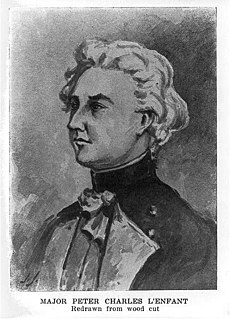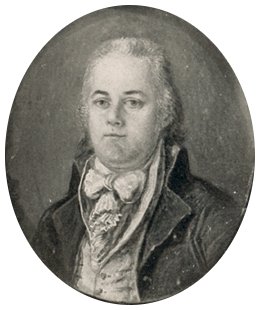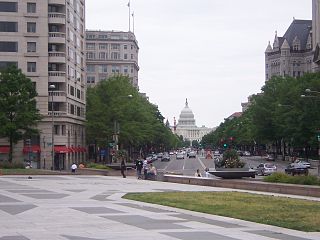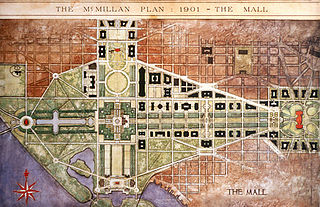Related Research Articles

The United States Capitol, often called The Capitol or the Capitol Building, is the meeting place of the United States Congress and the seat of the legislative branch of the U.S. federal government. It is located on Capitol Hill at the eastern end of the National Mall in Washington, D.C. Though no longer at the geographic center of the federal district, the Capitol forms the origin point for the district's street-numbering system and the district's four quadrants.

Frederick Law Olmsted was an American landscape architect, journalist, social critic, and public administrator. He was the father of American landscape architecture. Olmsted was famous for co-designing many well-known urban parks with his partner Calvert Vaux. Olmsted and Vaux's first project was Central Park, which resulted in many other urban park designs, including Prospect Park in New York City and Cadwalader Park in Trenton. He headed the pre-eminent landscape architecture and planning consultancy of late nineteenth-century America, which was carried on and expanded by his sons, Frederick Jr and John C, under the name Olmsted Brothers.

A parkway is a landscaped thoroughfare. The term is particularly used for a roadway in a park or connecting to a park from which trucks and other heavy vehicles are excluded.

Pierre "Peter" Charles L'Enfant was a French-American military engineer who designed the basic plan for Washington, D.C. known today as the L'Enfant Plan (1791).

Calvert Vaux was an English-American architect and landscape designer, best known as the co-designer, along with his protégé and junior partner Frederick Law Olmsted, of what would become New York City's Central Park.

The Residence Act of 1790, officially titled An Act for establishing the temporary and permanent seat of the Government of the United States, is a United States federal statute adopted during the second session of the First United States Congress and signed into law by President George Washington on July 16, 1790. The Act provides for a national capital and permanent seat of government to be established at a site along the Potomac River and empowered President Washington to appoint commissioners to oversee the project. It also set a deadline of December 1800 for the capital to be ready, and designated Philadelphia as the nation's temporary capital while the new seat of government was being built. At the time, the federal government was operating out of New York City.

Andrew Jackson Downing was an American landscape designer, horticulturist, and writer, a prominent advocate of the Gothic Revival in the United States, and editor of The Horticulturist magazine (1846–52). Downing is considered to be a founder of American landscape architecture.

The history of Washington, D.C., is tied to its role as the capital of the United States. Originally inhabited by an Algonquian-speaking people known as the Nacotchtank, the site of the District of Columbia along the Potomac River was first selected by President George Washington. The city came under attack during the War of 1812 in an episode known as the Burning of Washington. Upon the government's return to the capital, it had to manage the reconstruction of numerous public buildings, including the White House and the United States Capitol. The McMillan Plan of 1901 helped restore and beautify the downtown core area, including establishing the National Mall, along with numerous monuments and museums.

Andrew Ellicott was an American land surveyor who helped map many of the territories west of the Appalachians, surveyed the boundaries of the District of Columbia, continued and completed Pierre (Peter) Charles L'Enfant's work on the plan for Washington, D.C., and served as a teacher in survey methods for Meriwether Lewis.

Pennsylvania Avenue National Historic Site is a National Historic Site in the city of Washington, D.C. Established on September 30, 1965, the site is roughly bounded by Constitution Avenue, 15th Street NW, F Street NW, and 3rd Street NW. The historic district includes a number of culturally, aesthetically, and historically significant structures and places, including Pennsylvania Avenue NW from the White House to the United States Capitol, the Treasury Building, Freedom Plaza, Federal Triangle, Ford's Theatre, the Old Patent Office Building, the Old Pension Office Building, Judiciary Square, and the Peace Monument.
The National Capital Parks was a unit of the National Park System of the United States, now divided into multiple administrative units. It encompasses a variety of federally owned properties in and around the District of Columbia including memorials, monuments, parks, interiors of traffic circles and squares, triangles formed by irregular intersections, and other open spaces.

Frederick Law Olmsted Jr. was an American landscape architect and city planner known for his wildlife conservation efforts. He had a lifetime commitment to national parks, and worked on projects in Acadia, the Everglades and Yosemite National Park. He gained national recognition by filling in for his father on the Park Improvement Commission for the District of Columbia beginning in 1901, and by contributing to the famous McMillan Commission Plan for redesigning Washington according to a revised version of the original L’Enfant plan. Olmsted Point in Yosemite and Olmsted Island at Great Falls of the Potomac River in Maryland are named after him.

Jefferson Pier, Jefferson Stone, or the Jefferson Pier Stone, in Washington, D.C., marks the second prime meridian of the United States even though it was never officially recognized, either by presidential proclamation or by a resolution or act of Congress.
The streets and highways of Washington, D.C., form the core of the city's surface transportation infrastructure. Given that it is a planned city, streets in the capital of the United States follow a distinctive layout and addressing scheme. There are 1,500 miles (2,400 km) of public roads in the city, of which 1,392 miles (2,240 km) are owned and maintained by the district government.

The McMillan Plan is a comprehensive planning document for the development of the monumental core and the park system of Washington, D.C., the capital of the United States. It was written in 1902 by the Senate Park Commission. The commission is popularly known as the McMillan Commission after its chairman, Senator James McMillan of Michigan.

The National Capital Planning Commission (NCPC) is a U.S. government agency that provides planning guidance for Washington, D.C., and the surrounding National Capital Region. Through its planning policies and review of development proposals, the Commission seeks to protect and enhance the extraordinary resources of the national capital.

The L'Enfant Plan for the city of Washington is the urban plan developed in 1791 by Major Pierre (Peter) Charles L'Enfant for George Washington, the first president of the United States.
According to accounts that began to appear during the 1960s or earlier, a substantial mythology has exaggerated the accomplishments of Benjamin Banneker (1731–1806), who was a free African-American almanac author, surveyor, landowner and farmer who had knowledge of mathematics, astronomy and natural history. Well-known speakers, writers, artists and others have created, repeated and embellished a large number of such questionable reports during the two centuries that have elapsed since Banneker lived.

The Shipstead-Luce Act, is an American statute which extended the authority of the United States Commission of Fine Arts (CFA) as a statutory independent agency within the United States federal government and allowed it to regulate the height, exterior design, and construction of private and semi-public buildings in parts of the District of Columbia.
The following is a timeline of the history of the city of Washington, D.C., U.S.
References
- ↑ Philadelphia: A 300-Year History, pages 7, 14 – 16
- ↑ Leach, Sara Amy; Barthold, Elizabeth (1994-07-20). "L'Enfant Plan of the City of Washington, District of Columbia". National Register of Historic Places Registration Form. United States Department of the Interior: National Park Service . Retrieved 2012-01-08.
- ↑ Seale, William (1986). The President's House, Volume 1. White House Historical Association. pp. 1–4.
- 1 2 3 4 M., Ward, Robert (2011). Planning and community development A guide for the 21st century. WW Norton & Co. ISBN 9780393732924. OCLC 755061638.
- 1 2 3 "Olmsted and Vaux, Central Park". Khan Academy. Retrieved 2017-05-24.
- ↑ "History of Central Park, New York". www.ny.com. Retrieved 2017-05-24.
- 1 2 Peterson, Jon A. (2009-03-27). "The Birth of Organized City Planning in the United States, 1909–1910". Journal of the American Planning Association. 75 (2): 123–133. doi:10.1080/01944360802608484. ISSN 0194-4363.